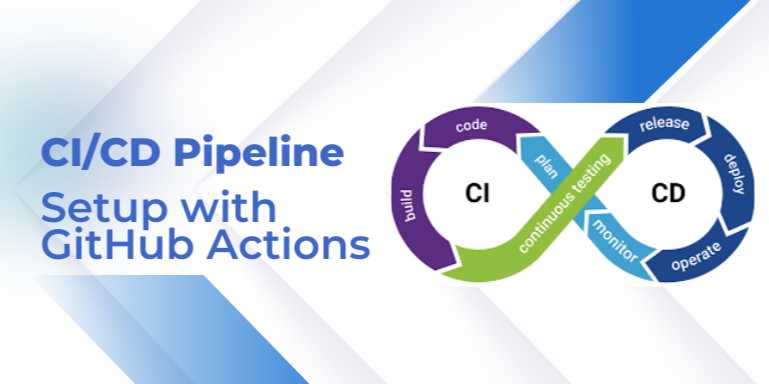Chapters
CI/CD Pipeline Setup with GitHub Actions: Automate Your Workflow from Code to Deployment

✅ Chapter 2: Creating Your First GitHub Actions Workflow
🔍 Introduction
Now that you understand the fundamentals of CI/CD and
GitHub Actions, it's time to get hands-on.
In this chapter, you will:
- Learn
the basic structure of a GitHub Actions workflow
- Create
your first real workflow from scratch
- Understand
triggers (events), jobs, steps, and actions
- Customize
workflows for different needs
- Troubleshoot
and monitor your first workflow execution
By the end of this chapter, you’ll have confidence to
automate simple build, test, and deployment tasks inside GitHub!
📋 Anatomy of a GitHub
Actions Workflow
A GitHub Actions workflow is a YAML file stored
inside your repository in:
bash
.github/workflows/
🔹 Key Components
|
Component |
Purpose |
|
Workflow |
Top-level definition
that groups all automation tasks |
|
Event |
Trigger that
starts the workflow |
|
Job |
Collection of steps to
perform tasks |
|
Step |
Individual
command or action |
|
Runner |
Machine that runs the
jobs (GitHub-hosted or self-hosted) |
📜 Basic Structure Example
yaml
name:
Build and Test
on:
[push]
jobs:
build:
runs-on: ubuntu-latest
steps:
- name: Checkout code
uses: actions/checkout@v3
- name: Install dependencies
run: npm install
- name: Run tests
run: npm test
🚀 Step-by-Step: Creating
Your First Workflow
Step 1: Create the Workflow Directory
In your repository:
bash
mkdir
-p .github/workflows
Step 2: Create a Workflow File
Create a file named ci.yml:
bash
touch
.github/workflows/ci.yml
Step 3: Write a Simple Workflow
Paste the following content into ci.yml:
yaml
name:
CI Workflow
on:
push:
branches:
- main
jobs:
build:
runs-on: ubuntu-latest
steps:
- name: Checkout repository
uses: actions/checkout@v3
- name: Set up Node.js
uses: actions/setup-node@v3
with:
node-version: 16
- name: Install packages
run: npm install
- name: Run unit tests
run: npm test
Step 4: Push the Workflow
Commit and push the workflow file:
bash
git
add .
git
commit -m "Add CI workflow"
git
push origin main
Step 5: Monitor Workflow Execution
Go to your GitHub repository → Click on the Actions
tab → See your workflow running live!
You can view:
- Logs
for each step
- Errors
and warnings
- Status
(Success, Failure)
🔔 Understanding Workflow
Triggers
Workflows are event-driven.
🔹 Common Events
|
Event |
Description |
|
push |
Triggered on code push |
|
pull_request |
Triggered
when a PR is opened/updated |
|
schedule |
Triggered on a cron
schedule |
|
workflow_dispatch |
Manual
trigger via GitHub UI |
|
release |
Triggered when a new
release is published |
📋 Example: Scheduled
Workflow
yaml
on:
schedule:
- cron: '0 0 * * *' # Every day at midnight UTC
📋 Example: Manual
Workflow Dispatch
yaml
on:
workflow_dispatch:
Manually trigger this workflow from GitHub’s UI!
⚙️ Setting up Different Runners
🔹 Default GitHub-hosted
Runners
GitHub provides ready-to-use virtual machines:
|
OS |
Label |
|
Ubuntu Linux |
ubuntu-latest |
|
Windows |
windows-latest |
|
macOS |
macos-latest |
🔹 Using a Specific Runner
yaml
runs-on:
ubuntu-latest
OR
yaml
runs-on:
windows-latest
🧰 Using Pre-built Actions
GitHub Actions has a Marketplace full of reusable Actions.
Popular ones:
|
Action |
Purpose |
|
actions/checkout |
Checkout source code |
|
actions/setup-node |
Set up
Node.js environment |
|
actions/setup-python |
Set up Python environment |
|
actions/cache |
Cache
dependencies |
|
docker/build-push-action |
Build and push Docker
images |
📋 Example: Using a
Third-Party Action
yaml
-
name: Upload Artifact
uses: actions/upload-artifact@v3
with:
name: build-artifact
path: dist/
Uploads the build folder (dist/) for later use!
🌟 Advanced Customization
Basics
Once comfortable, you can:
- Add multiple
jobs (build, test, deploy)
- Run jobs
in parallel or sequentially
- Use conditionals
(if: syntax)
- Create
matrix builds (e.g., Node.js 14/16/18)
- Use caches
to speed up workflows
📋 Example: Running Jobs
in Parallel
yaml
strategy:
matrix:
node: [14, 16, 18]
Tests on Node 14, 16, and 18 simultaneously!
📈 Best Practices for
First GitHub Workflows
|
Best Practice |
Why It Matters |
|
Keep workflows
simple initially |
Easier debugging |
|
Name steps clearly |
Easier to
trace logs |
|
Use secrets, not
hardcoded passwords |
Security |
|
Fail fast |
Exit early on
errors |
|
Modularize
workflows as they grow |
Maintainability |
🚀 Real-World Example:
Node.js Build and Deploy Workflow
yaml
name:
CI/CD
on:
push:
branches: [main]
jobs:
build:
runs-on: ubuntu-latest
steps:
- uses: actions/checkout@v3
- uses: actions/setup-node@v3
with:
node-version: 16
- run: npm install
- run: npm run build
deploy:
needs: build
runs-on: ubuntu-latest
steps:
- uses: actions/checkout@v3
- name: Deploy to server
run: echo "Deploying
application..."
Explanation:
- Build
job runs first
- Deploy
job waits for Build to succeed
📚 Common Issues When
Starting
|
Issue |
Reason |
Fix |
|
Workflow not
triggering |
Wrong branch or event
config |
Double-check on:
events |
|
Workflow fails immediately |
Bad YAML
syntax |
Validate YAML
formatting |
|
Steps fail
unexpectedly |
Wrong runner
environment |
Confirm runs-on is
correct |
|
Permission denied errors |
Secrets not
configured |
Set GitHub
Secrets properly |
🚀 Summary: What You
Learned in Chapter 2
- How
to create your first GitHub Actions workflow
- Understanding
jobs, steps, runners, and actions
- Setting
triggers: push, pull_request, schedule
- Using
pre-built Actions from Marketplace
- Best
practices to avoid common issues
Congratulations! You've successfully built your first
automated workflow with GitHub Actions!
FAQs
❓1. What is GitHub Actions?
Answer: GitHub Actions is a built-in automation tool
on GitHub that allows you to build, test, and deploy code directly from your
repositories by defining workflows triggered by events like pushes, pull
requests, and schedules.
❓2. What are the basic components of a GitHub Actions workflow?
Answer: A GitHub Actions workflow consists of workflows, jobs, steps, and actions:
- Workflows
define the entire pipeline.
- Jobs
are sets of steps that run sequentially or in parallel.
- Steps
are individual tasks like running commands.
- Actions
are pre-built reusable tasks.
❓3. How do I trigger a workflow in GitHub Actions?
Answer: Workflows can be triggered by:
- Events
(e.g., push, pull_request)
- Scheduled
times (cron jobs)
- Manual
triggers (workflow_dispatch)
- Repository
dispatches from external systems
❓4. Can I deploy applications automatically using GitHub Actions?
Answer: Yes! GitHub Actions can automate deployments
to servers, Kubernetes clusters, serverless platforms, or cloud providers like
AWS, Azure, and GCP after successful builds and tests.
❓5. How do I securely manage secrets like API keys or passwords in GitHub Actions?
Answer: GitHub provides a Secrets management
system where sensitive data (like API keys, credentials) can be stored and
injected into workflows securely without exposing them in code.
❓6. What types of environments can I run GitHub Actions workflows on?
Answer: GitHub Actions supports runners on:
- Ubuntu
Linux (ubuntu-latest)
- Windows
(windows-latest)
- macOS
(macos-latest) You can also set up self-hosted runners on your own
infrastructure.
❓7. What is the benefit of using caching in GitHub Actions workflows?
Answer: Caching (using actions/cache) helps store and
reuse dependencies between workflow runs, significantly reducing build times
and improving pipeline efficiency.
❓8. How can I create multi-environment CI/CD workflows (e.g., dev, staging, prod)?
Answer: You can create separate jobs or workflows for
each environment and control them with conditions (e.g., branch filters like
if: github.ref == 'refs/heads/prod') or use manual approvals for deployment
jobs.
❓9. Can I run tests across multiple versions of a programming language simultaneously?
Answer: Yes! You can use matrix builds in
GitHub Actions to test your application across multiple versions (e.g., Node.js
14, 16, and 18) at the same time, improving compatibility and quality
assurance.
❓10. Is GitHub Actions free to use?
Answer: GitHub Actions offers free usage with limits based on your account type:
- Public
repositories: Free unlimited usage
- Private
repositories: Free minutes with limits depending on GitHub plan (Free,
Pro, Team, Enterprise); extra usage may incur costs.
Tutorials are for educational purposes only, with no guarantees of comprehensiveness or error-free content; TuteeHUB disclaims liability for outcomes from reliance on the materials, recommending verification with official sources for critical applications.
Explore Other Libraries
Please allow ads on our site
Kindly log in to use this feature. We’ll take you to the login page automatically.
Login
Join Our Community Today
Ready to take your education and career to the next level? Register today and join our growing community of learners and professionals.

Your experience on this site will be improved by allowing cookies. Read Cookie Policy
Your experience on this site will be improved by allowing cookies. Read Cookie Policy

Comments(0)